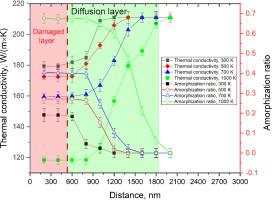Temperature effects of defect formation in BeO ceramics during helium blistering
IF 2.8
Q1 MATERIALS SCIENCE, CERAMICS
引用次数: 0
Abstract
The work is devoted to the study of the processes of defect accumulation in the near-surface layer of BeO ceramics associated with irradiation with low-energy He2+ ions, as well as to the establishment of the role of temperature effects on changes in thermal conductivity. Identification of the role of temperature effects in acceleration of the processes of distortion and disordering of the near-surface layers is one of the key tasks, the solution of which will allow more accurate prediction of the behavior of materials under extreme conditions combining the effects of high temperatures and radiation damage. During assessment of changes in structural parameters depending on variations in irradiation conditions, anisotropic distortion of the crystal lattice, the degree of deformation of which has a direct relationship with the temperature effect, was established. It has been determined that an increase in the irradiation temperature leads to an acceleration of the processes of accumulation of deformation distortions, the growth of which in the damaged layer leads to a more pronounced destabilization and broadening of the damaged layer depth. Such changes are associated with the acceleration of the diffusion processes of point and vacancy defects, the migration of which leads not only to an increase in deformation distortions and amorphous inclusions, but also to an increase in the damaged layer thickness. During determination of changes in the concentration of vacancy and structural defects in the damaged layer, relationships between the concentration of oxygen vacancies and the degradation of thermal conductivity, the reduction of which is due to an increase in the effects of phonon scattering and a decrease in the rate of heat transfer, were established.

氦泡胀过程中BeO陶瓷缺陷形成的温度效应
本工作致力于研究低能He2+离子辐照下BeO陶瓷近表层缺陷积累的过程,以及建立温度效应对导热系数变化的作用。确定温度效应在加速近表层变形和无序过程中的作用是关键任务之一,解决这一问题将允许更准确地预测材料在极端条件下的行为,结合高温和辐射损伤的影响。在评估结构参数随辐照条件变化的变化时,建立了晶格的各向异性畸变,其变形程度与温度效应有直接关系。已经确定,辐照温度的升高导致变形变形积累过程的加速,变形变形在损伤层中的增长导致更明显的不稳定和损伤层深度的扩大。这种变化与点缺陷和空位缺陷扩散过程的加速有关,点缺陷和空位缺陷的迁移不仅导致变形变形和非晶夹杂的增加,而且导致损伤层厚度的增加。在测定损伤层中空位和结构缺陷浓度的变化过程中,建立了氧空位浓度与导热系数下降之间的关系,导热系数的降低是由于声子散射效应的增加和传热速率的降低。
本文章由计算机程序翻译,如有差异,请以英文原文为准。
求助全文
约1分钟内获得全文
求助全文
来源期刊

Open Ceramics
Materials Science-Materials Chemistry
CiteScore
4.20
自引率
0.00%
发文量
102
审稿时长
67 days
 求助内容:
求助内容: 应助结果提醒方式:
应助结果提醒方式:


